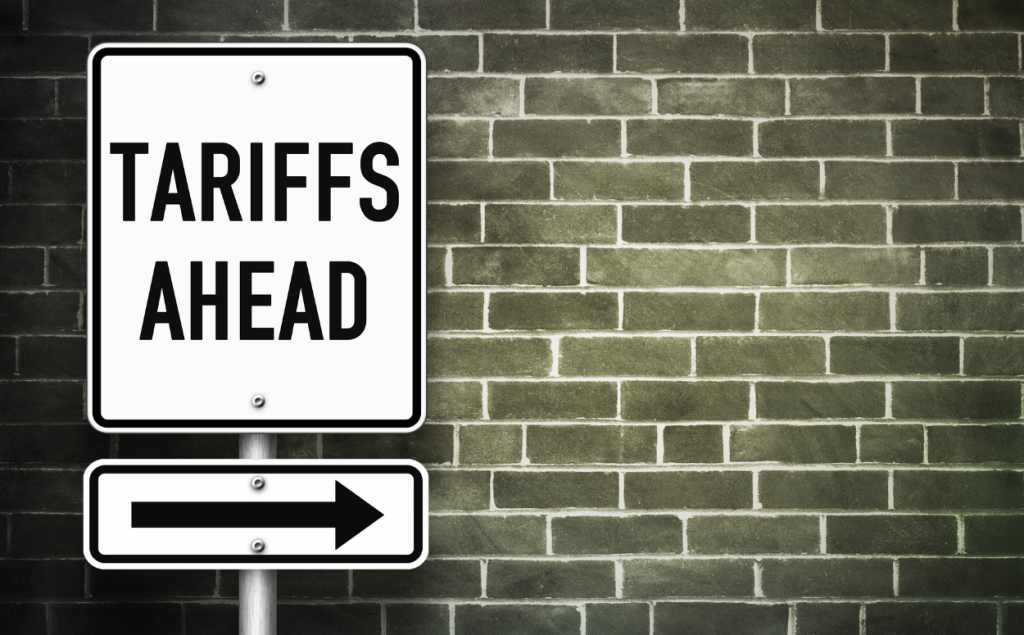Ideal Fulfillment shares how tariffs are reshaping the fulfillment industry. The global e-commerce industry has never been more dynamic—or more complicated. As we navigate 2025, one of the most disruptive forces shaping supply chains and fulfillment strategies is the shifting landscape of international tariffs. From heightened duties on Chinese imports to growing trade tensions between global powers, tariffs are no longer just line items on a spreadsheet—they’re strategic inflection points that are forcing companies to reevaluate everything from sourcing to last-mile delivery.
For brands selling on platforms like Shopify and TikTok Shop, the ripple effects of tariffs can significantly impact profit margins, customer experience, and fulfillment workflows. So, how exactly are tariffs are reshaping the fulfillment landscape in 2025, and what can forward-thinking businesses do to stay competitive?

Table of Contents
A Quick Recap: What Are Tariffs?
Tariffs are reshaping the way we handle the fulfillment industry. Tariffs are taxes imposed by a government on goods imported from other countries. In theory, they’re designed to protect domestic industries by making foreign products more expensive. But in practice, they can add a significant layer of cost and complexity to global commerce.
In 2025, we’re seeing tariffs used not just as economic tools but also as political instruments—leveraged in trade wars, environmental policy enforcement, and even digital regulation. This means businesses must now be more agile and proactive in their fulfillment strategies to weather the impact.
The 2025 Tariff Environment: What’s Changed?
1. Renewed Tariffs on Chinese Goods
In early 2025, the U.S. government reinstated and expanded tariffs on a wide range of goods imported from China, including electronics, textiles, auto parts, and packaging materials. This decision—prompted by ongoing tensions over intellectual property rights and digital surveillance concerns—has hit e-commerce sellers particularly hard.
Many of these goods are foundational to everyday operations in fulfillment: shipping boxes, plastic mailers, barcode scanners, and even warehouse machinery now come with higher price tags due to added duties.
2. Carbon Tariffs Are Now a Thing
As part of global climate initiatives, the European Union and other countries have implemented carbon border adjustment mechanisms (CBAMs). These essentially place tariffs on goods based on the carbon footprint of their production. For example, steel or cement made in countries with lax environmental policies will face steep import taxes when entering Europe or the U.S.
This new type of tariff has direct implications for packaging, shelving systems, and even warehouse construction materials.
3. Digital Service and Tech Tariffs
As more fulfillment companies adopt AI-driven platforms, robotics, and cloud-based infrastructure, digital service tariffs are becoming a new headache. Several countries have begun taxing foreign tech services, which can affect subscription costs for inventory software, data storage, and other SaaS tools commonly used in 3PL operations.
Tariffs and Fulfillment: What’s the Impact?
1. Increased Costs Across the Board
Tariffs are reshaping the fulfillment industry and Tariffs directly increase the cost of imported goods, but their impact is often felt throughout the entire fulfillment process:
- Packaging supplies cost more
- Warehouse equipment becomes more expensive to maintain or upgrade
- Tech subscriptions face price hikes due to software tariffs
- International shipping fees go up due to retaliatory tariffs or re-routing needs
For 3PLs and e-commerce sellers, these cost increases can quickly erode profit margins unless addressed strategically.
2. Inventory Strategy Shifts
Many brands are now rethinking their inventory strategies to avoid tariff-heavy imports:
- Nearshoring is gaining momentum as companies move production closer to home (e.g., Mexico or Canada) to sidestep tariffs.
- Diversified sourcing is becoming the norm. Businesses aren’t relying on a single country for raw materials or finished goods.
- Just-in-time inventory models are being replaced with just-in-case strategies—stockpiling key items to buffer against supply chain disruptions and tariff hikes.
These shifts are directly influencing how and where fulfillment centers store and manage inventory.
3. New Warehouse Locations
The rise in tariffs is also driving companies to reevaluate warehouse placement. In 2025, we’re seeing a strategic migration of fulfillment centers to locations that offer:
- Proximity to non-tariffed trade routes
- Access to alternative ports (e.g., East Coast over West Coast to avoid bottlenecks)
- Duty-free zones or foreign trade zones (FTZs), where companies can defer or reduce tariff costs
This reshuffling of warehouse networks can significantly alter delivery times and shipping costs, which in turn affects customer satisfaction.
4. Customs Compliance Becomes Critical
As tariffs grow more complex, customs documentation and classification are under increased scrutiny. Misclassifying a product’s origin or category can result in fines, shipment delays, or even legal action. Tariffs are reshaping how fulfillment is ran.
This is pushing fulfillment centers to:
- Invest in compliance management tools
- Hire trade specialists or work with customs brokers
- Implement better SKU-level tracking systems to monitor product origin and routing
Fulfillment providers that can’t keep up with these requirements risk losing clients to more agile competitors.
How E-Commerce Brands Are Adapting Because Tariffs are Reshaping
1. Switching to U.S.-Based 3PLs
Brands that previously relied on overseas fulfillment—especially from Chinese warehouses or direct-from-factory shipping—are now turning to U.S.-based 3PLs to avoid import tariffs entirely. This “reshoring” of fulfillment is helping brands:
- Improve shipping times
- Avoid customs delays
- Maintain tighter quality control
- Cut tariff-related costs
A domestic 3PL like Ideal Fulfillment becomes a strategic partner in this scenario—helping e-commerce sellers not only store and ship their products, but also navigate complex regulatory environments.
2. Changing Product Lines
Some businesses are redesigning products to avoid high-tariff categories altogether. For instance:
- Moving from plastic-heavy packaging to biodegradable alternatives sourced locally
- Replacing imported electronics with components assembled in North America
- Shifting from apparel sourced in China to those made in countries with favorable trade agreements
Fulfillment partners must now accommodate these new product specs, from different storage needs to revised packing instructions.
3. Tariff Engineering
Some brands are engaging in what’s called tariff engineering—designing products or packaging in ways that reduce their tariff classification. For example:
- Slight modifications that shift an item to a lower-duty category
- Assembling products in the U.S. from imported parts to qualify for “Made in USA” labeling
These changes impact fulfillment processes, especially when assembly or kitting is part of the service offering.
What Fulfillment Centers Need to Do to Stay Competitive
To remain relevant in this evolving trade environment, fulfillment centers must pivot quickly and offer solutions that help clients mitigate tariff impacts.
1. Offer Import Assistance & Trade Expertise
Fulfillment providers can stand out by helping clients:
- Classify products accurately
- Navigate CBP (Customs and Border Protection) rules
- Optimize shipping routes for duty savings
Whether through in-house experts or partner networks, having this support is now a major value-add.
2. Expand International Fulfillment Options
Global fulfillment networks are becoming more important, not less. Fulfillment centers that can offer:
- EU-based warehousingfor European customers
- Canada/Mexico hubs for North American trade efficiency
- Partnerships in non-tariffed regions like Vietnam or India
…are positioned to attract clients looking for more resilient, tariff-proof logistics solutions.
3. Build Sustainable Practices
With environmental tariffs on the rise, fulfillment providers must:
- Adopt eco-friendly packaging options
- Report carbon data transparently
- Help brands meet sustainability goals to avoid green tariffs
Sustainability is no longer just good PR—it’s becoming a compliance necessity.
Looking Ahead: What to Expect in Late 2025 and Beyond
The role of tariffs in shaping fulfillment is only expected to intensify as the year goes on. With upcoming elections in major economies, evolving climate legislation, and ongoing geopolitical shifts, tariff policy will remain in flux.
Key developments to watch:
- Potential new tariffs on AI-powered tech tools and autonomous delivery systems
- Expansion of carbon tariffs to cover more categories, including food and apparel
- U.S. legislative debates around digital imports and data storage taxes
For fulfillment centers and e-commerce brands alike, staying flexible and well-informed will be essential to thriving in this environment.

Final Thoughts: Turning Tariff Trouble into a Competitive Advantage
While tariffs are undeniably a challenge, they also present a unique opportunity for fulfillment providers and e-commerce sellers to innovate and differentiate. Those who act quickly—by realigning sourcing, rethinking inventory strategies, and partnering with agile fulfillment centers—can not only survive tariff upheaval but come out ahead of the competition.
In a world where the rules of trade are constantly changing, having the right fulfillment partner can make all the difference.
Looking to optimize your fulfillment strategy in the face of growing tariff pressures? Reach out to Ideal Fulfillmentto see how we can help you stay compliant, cost-effective, and customer-focused in 2025 and beyond.
